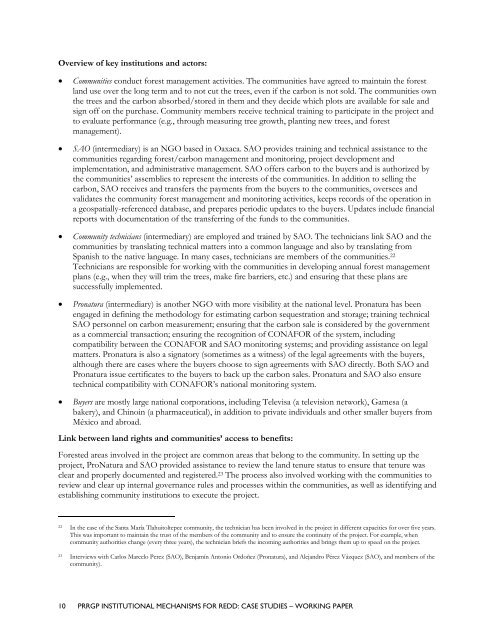Institutional Mechanisms for REDD+ - Case Studies Working Paper
Institutional Mechanisms for REDD+ - Case Studies Working Paper
Institutional Mechanisms for REDD+ - Case Studies Working Paper
You also want an ePaper? Increase the reach of your titles
YUMPU automatically turns print PDFs into web optimized ePapers that Google loves.
Overview of key institutions and actors:<br />
� Communities conduct <strong>for</strong>est management activities. The communities have agreed to maintain the <strong>for</strong>est<br />
land use over the long term and to not cut the trees, even if the carbon is not sold. The communities own<br />
the trees and the carbon absorbed/stored in them and they decide which plots are available <strong>for</strong> sale and<br />
sign off on the purchase. Community members receive technical training to participate in the project and<br />
to evaluate per<strong>for</strong>mance (e.g., through measuring tree growth, planting new trees, and <strong>for</strong>est<br />
management).<br />
� SAO (intermediary) is an NGO based in Oaxaca. SAO provides training and technical assistance to the<br />
communities regarding <strong>for</strong>est/carbon management and monitoring, project development and<br />
implementation, and administrative management. SAO offers carbon to the buyers and is authorized by<br />
the communities‘ assemblies to represent the interests of the communities. In addition to selling the<br />
carbon, SAO receives and transfers the payments from the buyers to the communities, oversees and<br />
validates the community <strong>for</strong>est management and monitoring activities, keeps records of the operation in<br />
a geospatially-referenced database, and prepares periodic updates to the buyers. Updates include financial<br />
reports with documentation of the transferring of the funds to the communities.<br />
� Community technicians (intermediary) are employed and trained by SAO. The technicians link SAO and the<br />
communities by translating technical matters into a common language and also by translating from<br />
Spanish to the native language. In many cases, technicians are members of the communities. 22<br />
Technicians are responsible <strong>for</strong> working with the communities in developing annual <strong>for</strong>est management<br />
plans (e.g., when they will trim the trees, make fire barriers, etc.) and ensuring that these plans are<br />
successfully implemented.<br />
� Pronatura (intermediary) is another NGO with more visibility at the national level. Pronatura has been<br />
engaged in defining the methodology <strong>for</strong> estimating carbon sequestration and storage; training technical<br />
SAO personnel on carbon measurement; ensuring that the carbon sale is considered by the government<br />
as a commercial transaction; ensuring the recognition of CONAFOR of the system, including<br />
compatibility between the CONAFOR and SAO monitoring systems; and providing assistance on legal<br />
matters. Pronatura is also a signatory (sometimes as a witness) of the legal agreements with the buyers,<br />
although there are cases where the buyers choose to sign agreements with SAO directly. Both SAO and<br />
Pronatura issue certificates to the buyers to back up the carbon sales. Pronatura and SAO also ensure<br />
technical compatibility with CONAFOR‘s national monitoring system.<br />
� Buyers are mostly large national corporations, including Televisa (a television network), Gamesa (a<br />
bakery), and Chinoin (a pharmaceutical), in addition to private individuals and other smaller buyers from<br />
México and abroad.<br />
Link between land rights and communities’ access to benefits:<br />
Forested areas involved in the project are common areas that belong to the community. In setting up the<br />
project, ProNatura and SAO provided assistance to review the land tenure status to ensure that tenure was<br />
clear and properly documented and registered. 23 The process also involved working with the communities to<br />
review and clear up internal governance rules and processes within the communities, as well as identifying and<br />
establishing community institutions to execute the project.<br />
22 In the case of the Santa María Tlahuitoltepec community, the technician has been involved in the project in different capacities <strong>for</strong> over five years.<br />
This was important to maintain the trust of the members of the community and to ensure the continuity of the project. For example, when<br />
community authorities change (every three years), the technician briefs the incoming authorities and brings them up to speed on the project.<br />
23 Interviews with Carlos Marcelo Perez (SAO), Benjamín Antonio Ordoñez (Pronatura), and Alejandro Pérez Vázquez (SAO), and members of the<br />
community).<br />
10 PRRGP INSTITUTIONAL MECHANISMS FOR REDD: CASE STUDIES – WORKING PAPER

















